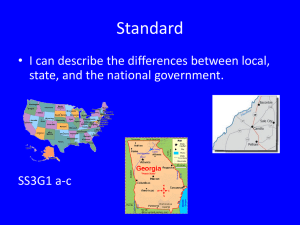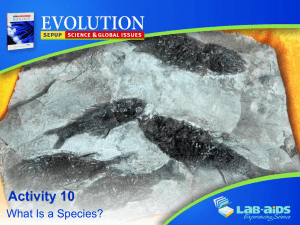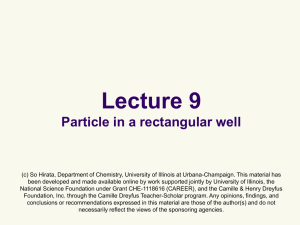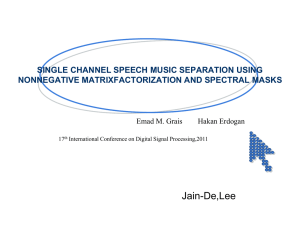MSword
advertisement
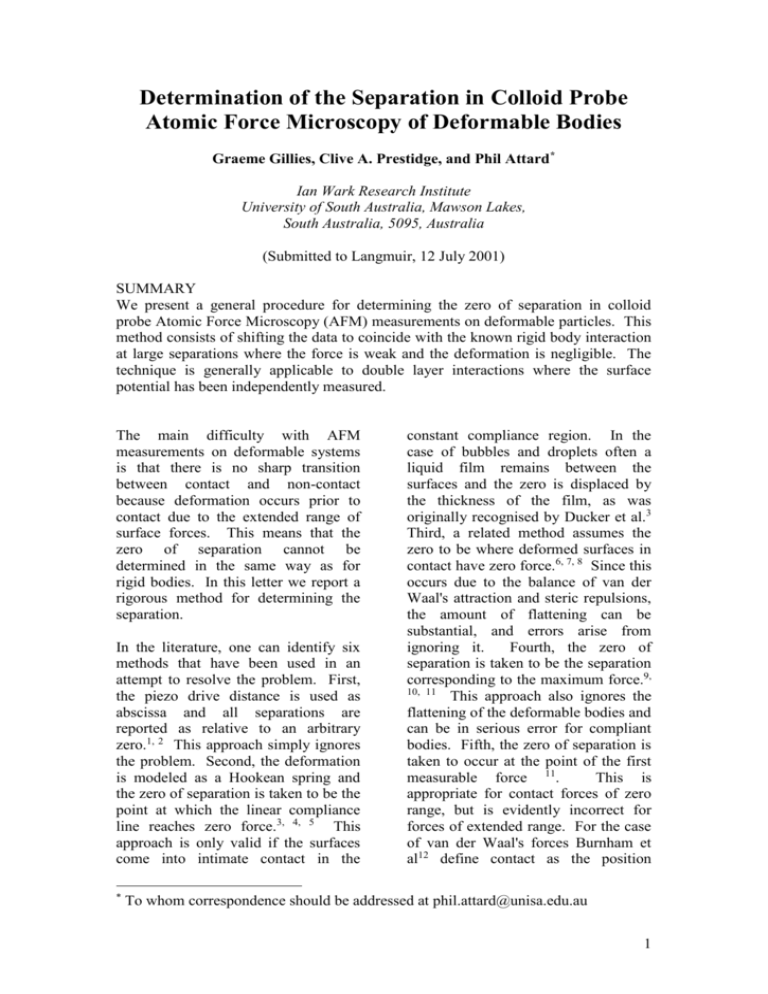
Determination of the Separation in Colloid Probe Atomic Force Microscopy of Deformable Bodies Graeme Gillies, Clive A. Prestidge, and Phil Attard* Ian Wark Research Institute University of South Australia, Mawson Lakes, South Australia, 5095, Australia (Submitted to Langmuir, 12 July 2001) SUMMARY We present a general procedure for determining the zero of separation in colloid probe Atomic Force Microscopy (AFM) measurements on deformable particles. This method consists of shifting the data to coincide with the known rigid body interaction at large separations where the force is weak and the deformation is negligible. The technique is generally applicable to double layer interactions where the surface potential has been independently measured. The main difficulty with AFM measurements on deformable systems is that there is no sharp transition between contact and non-contact because deformation occurs prior to contact due to the extended range of surface forces. This means that the zero of separation cannot be determined in the same way as for rigid bodies. In this letter we report a rigorous method for determining the separation. In the literature, one can identify six methods that have been used in an attempt to resolve the problem. First, the piezo drive distance is used as abscissa and all separations are reported as relative to an arbitrary zero.1, 2 This approach simply ignores the problem. Second, the deformation is modeled as a Hookean spring and the zero of separation is taken to be the point at which the linear compliance line reaches zero force.3, 4, 5 This approach is only valid if the surfaces come into intimate contact in the * constant compliance region. In the case of bubbles and droplets often a liquid film remains between the surfaces and the zero is displaced by the thickness of the film, as was originally recognised by Ducker et al.3 Third, a related method assumes the zero to be where deformed surfaces in contact have zero force.6, 7, 8 Since this occurs due to the balance of van der Waal's attraction and steric repulsions, the amount of flattening can be substantial, and errors arise from ignoring it. Fourth, the zero of separation is taken to be the separation corresponding to the maximum force.9, 10, 11 This approach also ignores the flattening of the deformable bodies and can be in serious error for compliant bodies. Fifth, the zero of separation is taken to occur at the point of the first measurable force 11. This is appropriate for contact forces of zero range, but is evidently incorrect for forces of extended range. For the case of van der Waal's forces Burnham et al12 define contact as the position To whom correspondence should be addressed at phil.attard@unisa.edu.au 1 where a repulsion is first detectable, which they took to be signified by a change in curvature of the force. A related method fixes the zero of relative separation at an arbitrary small force,13 which allows comparison of data with the same force law but not if the forces are of different magnitude or type. Sixth, Mulvaney et al. 14 fit the non-linear Poisson-Boltzmann equation for rigid bodies by adjusting both the zero of the experimental separation and the surface potential. The problem with this approach is that it ignores the deformation at small separations, which is where the linear and the non-linear Poisson-Boltzmann equations differ, and at large separations an arbitrary change in surface potential can be compensated by a change in separation. In other words, one cannot determine unique values for the potential and the zero of separation simultaneously. The method we propose here uses the linear Poisson-Boltzmann equation for rigid bodies at large separations to establish the zero of experimental separation. The rationale for the method is that even soft bodies behave as if they were rigid for weak enough forces. The method requires that the surface potential be independently measured (eg by electrophoresis). However, beyond this restriction it is generally applicable to AFM measurements of charged deformable particles. The renormalised linear Boltzmann equation is Poisson- F 40 r R4k BT / q 1 2e h Here F is the force between a flat substrate and a sphere of radius R, 0 is the permitivity of free space, r is the relative dielectric constant of the aqueous medium, kB is Boltzmann's 2 constant, T is the absolute temperature, q is the ionic charge, is the Debye length of the electrolyte, and h is the separation. The renormalised potential is tanh q 4 k BT where is the surface potential. The separation that appears here is that between the two surface charges. The experimental data is shifted horizontally to coincide with this force law at large separations. Figure 1 illustrates the method for a soft solid cross-linked PDMS particle (for details see reference 17). The zero of separation has been established by shifting the force vs. distance data to coincide with the linear PoissonBoltzmann theory for rigid bodies. From the decay length of the data, 9.6 nm, it can be seen that the particle does indeed behave as a rigid body at large separations. We used the measured zeta-potentials15, 16 in calculating the Poisson-Boltzmann curve, which allows the zero to be established unambiguously. We have renormalised the potentials to the nonlinear Poisson-Boltzmann asymptote 18 . We have also performed elastic deformation calculations19, 20 using the renormalised force law. It can be seen that these also go over to the rigid body result at large separations, which confirms that the procedure is exact. (There is no arbitrary zero in the theoretical calculations.) Negative nominal separations correspond to interpenetration of undeformed bodies; the actual separation is always positive. Both the elastic theory and the experimental data deviate from the linear Poisson-Boltzmann law at higher loads as deformation becomes important. Using a Young's modulus of 1 MPa, the elastic theory 2 overestimates the extent of the deformation but shows the same qualitative behaviour as the experiment. We shall show in a more detailed study that viscoelastic effects and steric interactions are important in this PDMS particle system 17. Figure 2 shows a representative selection of data from AFM measurements on a sodium dodecyl sulphate (SDS) stabilised oil drop in 0.01mM of SDS13. Again at large separations the slope of the force data coincides with the Debye length and the zero of separation has been established by shifting the separation to agree with the renormalised linear Poisson-Boltzmann equation using the measured zeta-potentials for silica15 (- 70 mV) and SDS stabilised n-decane21 (-100 mV). Furthermore, at higher loads the data increases less rapidly than the rigid body result, in agreement with a theory that treats the interface as a simple spring.22 In summary, we have presented a general procedure for determining the zero of separation in AFM measurements of deformable particles. The method consists of shifting the data to coincide with the known rigid body interaction at large separations where the force is weak and the deformation is negligible. The technique is generally applicable to double layer interactions where the surface potential has been independently measured. -1.5 Log10 F/Rp (N/m) -2 -2.5 -3 -3.5 -4 -4.5 -30 -20 -10 0 10 20 Nominal Separation (nm) 30 40 50 Figure 1. AFM measurements17 of the force (F) between a silica sphere (R1 = 5 m) and a soft PDMS particle (R2 = 0.5 m) in 1 mM KNO3 at pH 9.3, normalised by (Rp-1 = R1-1 + R2-1). The bold line is the rigid body renormalised linear Poisson-Boltzmann result using the measured zeta-potentials, 1 = -70 mV15 and 2 = -46 mV,16 (shown dashed past contact). The solid curve is the calculated force for an elastic body with a Young's modulus of 1 Mpa.19,20 3 0.5 Log10 F/Rp (mN/m) 0 -0.5 -1 -1.5 -2 -80 -60 -40 -20 0 20 40 60 Nominal Separation (nm) Figure 2. AFM measurements of the force between a silica sphere (R1 = 3 m) and an n-decane oil droplet (R2 = 0.25 mm) in 1mM NaNO3 in the presence of 10-5 M sodium dodecyl sulphate13. The bold line is the linear rigid body Poisson-Boltzmann result using the measured zeta-potentials, 1 = -70 mV15 and 2 = -100 mV,21 and the curve is theoretical calculation that treats the interface as effective spring.22 The error in the experimental data is comparable to the size of the symbols. 1 Weisenhorn, A.; Khorsandi, M.; Kasas, S.; Gotzos, V.; Butt, H.-J. Nanotechnology, 1993, 4, 106. 2 Burnham, N.; Dominguez, D.; Mowery, R.; Colton, R. Phys. Rev. Let. 1990, 64, 1931. 3 Ducker, W.; Xu, Z.; Israelachivili, J. Langmuir, 1994, 10, 3279. 4 Fielden, M.; Hayes, R.; Ralston, J. Langmuir, 1996, 12, 3721. 5 Preuss, M.; Butt, H.-J. Langmuir, 1998, 14, 3164. 6 Weisenhorn, A.; Maivald, P.; Butt, H.-J.; Hansma, P. Phys. Rev. B, 1992, 45, 11226. 7 Snyder, B.; Aston, D.; Berg, J. Langmuir, 1997, 13, 590. 8 Burnham, N.; Colton, R. J. Vacuum Sci. Tech. 1987, 7, 2906. 9 Considine, R.; Hayes, R.; Horn. Langmuir, 1999, 15, 1657. 10 Schmitt F.-J.; Ederth, T.; Weidenhammer, P.; Claesson. P.; Jacobasch, H.-J. J. Adhesion Sci. Tech. 1999, 13, 79. 11 Aston, D.; Berg, J.; J. Colloid and Interf. Sci. 2001, 235, 162. 12 Burnham, N. A.; Colton R. J.; Pollock, H. M. Nanotechnology. 1993, 4, 64. 13 Hartley, P.; Grieser, F.; Mulvaney, P.; Stevens, G. Langmuir. 1999, 15, 7882. 14 Mulvaney, P.; Perera, J.; Biggs, S.; Grieser, F.; Stevens, G. J. Colloid and Interf. Sci. 1996, 183, 614. 15 Hartley, P.; Larson, I.; Scales, P. Langmuir, 1997, 13, 2207. 16 Barnes, T.; Prestidge, C. Langmuir, 2000, 16, 4116. 17 Gillies, G.; Prestidge, C.; Attard. P. In preparation. 18 Attard, P. J. Phys. Chem. 1995, 99, 14174. 19 Attard, P. Phys. Rev. E, 2001, 63, 061604-(1-9). 20 Attard, P. J. Phys. Chem. B, 2000, 104, 10635. 21 Nespolo, S.; Bevan, M.; Chan, D.; Grieser, F.; Stevens, G.; Langmuir. Submitted. 22 Attard. P.; Miklavic, S. J. Colloid and Interf. Sci.. Submitted. 4

